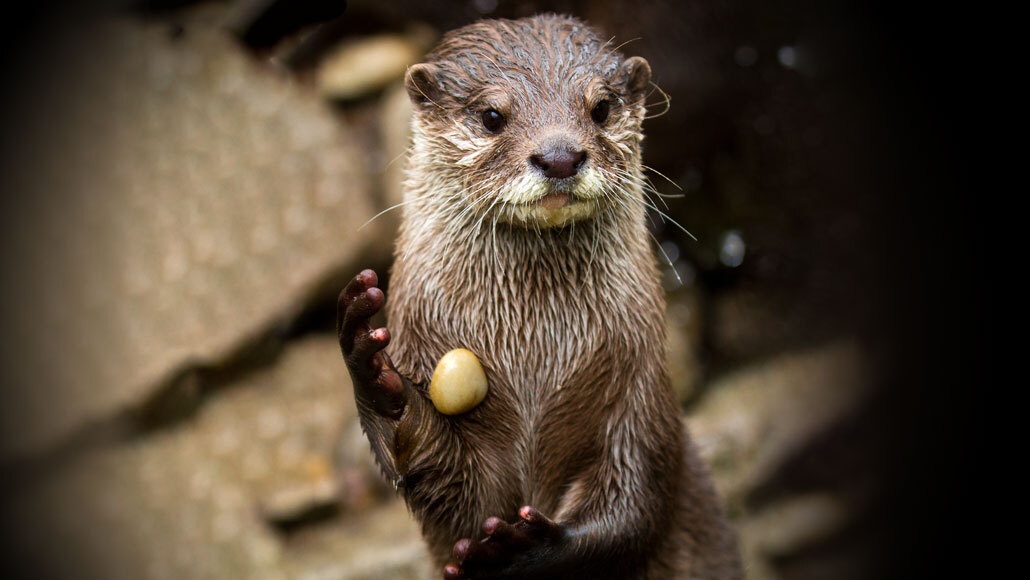
Asian small-clawed otters “juggle” by shifting a stone swiftly from paw to paw.
Cloudtail_the_Snow_Leopard/iStock/Getty Images Plus
A lovely, intuitive idea about why otters juggle rocks — that it helps them practice survival skills — might not be correct, new tests show.
The term “juggling” is itself overenthusiastic. Otters don’t keep stones flying around in some tall, aerial circle. Instead, the animals shuffle rocks back and forth quickly between their front paws. “It’s very close to the body,” says animal behaviorist Mari-Lisa Allison, who studied the behavior as a graduate student at the University of Exeter in England.
Such deft fiddling looks as if it might make a great example of how animal play could serve as practice for real-life challenges. In the wild, small-clawed otters need paw dexterity to tweak shreds of seafood out of crustacean or mollusk shells. And yet, three kinds of tests found no evidence that juggling builds otters’ food-picking skills, Allison and her colleagues report May 6 in Royal Society Open Science.
The question of how play evolved (SN: 2/6/18) has long fascinated biologists. According to the latest thinking, play behaviors serve no immediate practical need. Yet even the mild tussles of puppies and kittens take energy and carry some risk of injury, so it seems that some benefit must counterbalance those downsides.
Asian small-clawed otters (Aonyx cinerea), the littlest of the 13 otter species, are “very playful,” Allison says. Smooth-coated otters (Lutrogale perspicillata) also juggle rocks but eat fish that don’t require deft plucking of food tidbits from shells.
Because the otters eat in different ways, Allison originally predicted that the active paws of the shellfish eaters in three wildlife collections would surpass the simple fish grabbers in their skill at pulling bits of meat out of crevices. Regardless of their differences in feeding styles, however, both kinds of otters proved equally able to winkle some meat out of challenging objects. Rock play didn’t seem to matter in learning a life skill.
Allison and colleagues tested both species by tucking minced meat into three kinds of inconvenient and unfamiliar containers: plastic medicine bottles with screw-on caps, pierced green tennis balls and toys resembling clamshells made of two oversized Lego-like blocks. (Real Lego blocks, she worried, were small enough to become a choking hazard for the otters.)
Especially frequent rock-twiddling among the small-clawed otters, however, didn’t give individuals a noticeable edge in working tidbits out of awkward containers. Instead, the study linked surges of rock juggling to the approach of feeding time, with more juggling as lunch drew nigh.
Also, it wasn’t just youngsters that played with rocks: Elderly otters past reproductive age likewise did a lot of paw fiddling. So, again, juggling may not be only a way for youngsters to practice skills for feeding.
The possible disconnect between play and real-life skills doesn’t startle Gordon Burghardt of the University of Tennessee, Knoxville. Over decades, he has analyzed play behavior, refining definitions and even reporting play in such unexpected animals as a turtle romping with a basketball in a zoo. The thinking about the evolution of play has by now expanded beyond simple notions of the benefits of instinctive practice, he says.
Play is more likely to evolve, Burghardt has pointed out, among animals with parental care that give youngsters enough surplus food and a safe space for goofing around. He calls this the “surplus resource” hypothesis, and otters are a good example of it (SN: 6/13/14). Otters that juggle may be doing so “for pleasure, out of boredom, or both,” he says. Either way, he says, they’re drawing on “part of their evolutionary heritage.”






